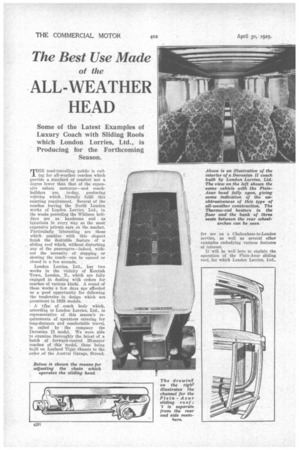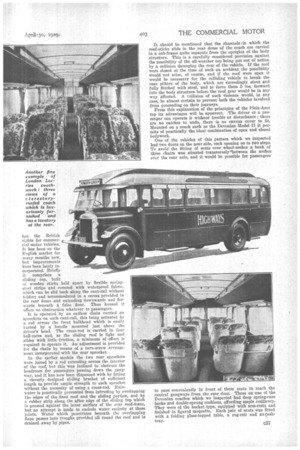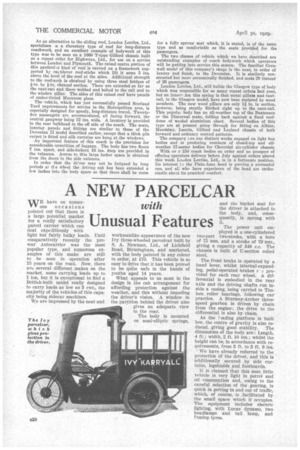The Best Use Made
Page 66

Page 67

Page 68

If you've noticed an error in this article please click here to report it so we can fix it.
of the
ALL-WEATHER HEAD
Some of the Latest Examples of Luxury Coach with Sliding Roofs which London Lorries, Ltd., is Producing for the Forthcoming Season.
road-travelling public is call
ing for all-weather coaches which provide a standard of comfort not a degree lower than that of the expensive saloon motorcar—and coachbuilders are, to-day, producing vehicles which . literally fulfil this exacting requirement. Several of the coaches , leaving the North London Works of London Lorries, Ltd., in the weeks prece.ding the Whitsnn as handsome and as luxurious in every way as the most expensive private cars on the market. Particularly .interesting are those which combine with this elegant finish the desirable feature of a sliding roof which, without disturbing any of the passengers—indeed, with! out the necessity of stopping or slowing the coach—can be opened or closed in a few seconds. ,
London Lorries, Ltd., has two works in the vicinity of Kentish Town, .London, N., which are fully engaged in dealing with orders for coaches of various kinds. A round of these: works a few days ago afforded us a good opportunity for .following the tendencies in design which are prominent in 1029 models.
A tyrne of coach body which, according to London Lorries, Ltd., is representative of this season's requirements of operators catering for long-distance and comfortable travel, is called by the company the Devonian II model. We were able to examine thoroughly the latest of a batch of forward-control 26-seater coaches of this model, these being bnilt on Leyland Tiger chassis to the order of the Austral Garage, Stroud,
It should be mentioned that the channels in which the roof-sticks slide in the rear dome of the coach are carried in a sub-frame quite separate from the uprights of the body structure. This is a carefully considered provision against the possibility of the all-weather top being put out of action by a collision damaging the rear of the vehicle. If the roof were closed at the time of such an accident the possibility would not arise, of course, and if the roof were open it would be necessary for the colliding vehicle to break the rear pillars of the body, which are exceedingly stout and fully flitched with steel, and to force them 5 ins, forward into the body structure before the roof gear would be in any way affected. A collision of such violence would, in any case, be almost certain to prevent both the vehicles involved from proceeding on their journeys.
From this explanation of the principles of the Plein-Azuz top its advantages will be apparent. The driver or a passenger can operate it without trouble or disturbance; there are no catches to undo, there is no canvas cover to fit. Mounted on a coach such as the Devonian Model II it permits of practically the ideal combination of open and closed bodywork.
One of the vehicles of this pattern which we inspected had two doors on the near side, each opening on to two steps. To avoid the fitting of seats over wheel-arches a bank of three chairs was situated transversely 'between the arches over the rear axle, and it would be possible for passengers has the British rights for commercial motor vehicles. It has been on the English market for many months now, but improvements have been lately incorporated. Briefly it comprises a sliding top, built of wooden sticks held apart by flexible springsteel strips and covered with waterproof fabric, which can be slid back along the cant-rail without folding and accommodated in a recess provided in the rear dome and extending downwards and forwards beneath a false floor. Thus housed it offers no obstruction whatever to passengers.
It is operated by an endless chain carried on sprockets on each cant-rail, this being actuated by a rod across the front bulkhead which is easily turned by a handle mounted just above the driver's head. The cross-rod is carried in four ball-races and, as the sliding roof is light and slides with little friction, a minimum of effort is required to operate it. An adjustment is provided for the chain by means of a turn-screw arrangement incorporated with the rear sprocket.
In the earlier models the two rear sprockets were joined by a rod extending across the interior of the roof, but this was inclined to obstruct the headroom for passengers passing down the gangway, and it has now been dispensed with by fitting u cleverly designed sliding bracket of sufficient length to provide ample strength to each sprocket without the necessity of using a cross-rod. Rainwater is practically prevented from intruding by overlapping the edges of the fixed roof and the sliding portion, and by a rubber strip along the after edge of the sliding top -which is pressed against the inner surface of the rear roof-dome, but no attempt is made to exclude water entirely at these joints. Water which penetrates beneath the overlapping flaps passes into troughs provided all round the roof and is drained away by pipes.
to pass conveniently in front of these seats to reach the central gangways from the rear door. Those on one of the Devonian coaches which we inspected had deep spring-case backs and double-sprung cushions, affording ample resiliency. They were of the bucket type, equipped with arm-rests and finished in figured moquette. Each pair of seats was fitted with a folding glass-topped table, a rug-rail and aniashtray. As an alternative to the sliding roof, London Lorries, Ltd., specializes a a clerestory type of roof for long-distance coachwork, and an excellent example of bodywork of this type was to be seen on a 1660 T-type Gilford chassis built as a repeat order for Highways, Ltd., for use on a service between London and Plymouth. The raised centre portion of this particul tr kind of roof is carried on a framework supported Iv caltilever roof-sticks which lift it some 5 ins. above the level of the roof at the sides. Additional strength to the roOf-arch is obtained by using three steel bridges of 1-in. by 1-in, channel section. These are extended so far as the cant-ran and there webbed and bolted to the rail and to the window pillar. The sides of this raised roof have panels of amber-tinted Muranese glass.
The vehicle, which has just successfully passed Scotland Yard requirements for service in the Metropolitan area, is especially designed for speedy, long-distance travel. Twentyfive passengers are accommodated, all facing forward, the central gangway being 12 ins. wide. A lavatory is provided in the rear bulkhead in the off side of the coach. The seats, interior panel; and fittings are similar to those of the Devonian II model described earlier, except that a thick pile carpet is fitted and silk curtains are hung at the windows.
An important feature of this coach is the provision for considerable quantities of luggage. The body has two floors 7 ins, apart, and side-lockers 16 ins, deep are provided in the valances. Access to this large locker space is obtained from the doors in the side valances.
In order that the dr:ver may not be fatigued by long periods al tl e wheel the driving cab has been extended a few inches into the body space so that there shall be room for a fully sprung seat which, it is stated, is of the same type and as comfortable as the seats provided for the passengers.
The two classes of vehicle which we have described are outstanding examples of coach bodywork which operators will be putting into service this season. The familiar Cornwall model of this company's range is the next, in order of luxury, and finish, to the Devonian. It is similarly constructed but more economically finished, and seats 20 instead of 26 passengers.
London Lorries, Ltd., still builds the Glasgow typo of body which was responsible for so many repeat orders last year, but an hinny.] don this spring is that metal pillars and cantrail, in the Glasgow model, have now been replaced by wood members. The new wood pillars are only 11 in. in section, however, being stoutly ilitched right up to the cant-rail. This popula.• body has an all-weather top of the Beatonson or the Disturnal make, folding back against a fixed roofdome of welded aluminium sheet. Several bodies of this type are at present going through for fitting on Albion, Mandalay, Lancia, Gilford and Leyland chassis of both forward and ordinary control patterns.
The company Los one distinct works engaged on light bus bodies and is producing numbers of dosed-top and allweather 17-seater bodies for Chevrolet six-cylinder chassis.
With ov r 150 coach bodies on order and no prospect of offering operators delivery before July against orders placed this week, Lo,idon Lorries, Ltd., is in a fortunate position. Its interest i t the Plein-Azur head is proving a successful one, and aE who have experience of the head are enthusiastic about its practical comfort.




























































































































